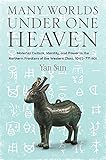Many worlds under one Heaven : material culture, identity, and power in the northern frontiers of the Western Zhou, 1045-771 BCE / Yan Sun.
Material type: TextSeries: Description: 1 online resource (xvii, 310 pages) : illustrations, mapsContent type:
TextSeries: Description: 1 online resource (xvii, 310 pages) : illustrations, mapsContent type: - text
- computer
- online resource
- 9780231552622
- DS747 .M369 2021
- COPYRIGHT NOT covered - Click this link to request copyright permission: https://lib.ciu.edu/copyright-request-form
| Item type | Current library | Collection | Call number | URL | Status | Date due | Barcode | |
|---|---|---|---|---|---|---|---|---|
 Online Book (LOGIN USING YOUR MY CIU LOGIN AND PASSWORD)
Online Book (LOGIN USING YOUR MY CIU LOGIN AND PASSWORD)
|
G. Allen Fleece Library ONLINE | Non-fiction | DS747 (Browse shelf(Opens below)) | Link to resource | Available | on1226800677 |
Includes bibliographies and index.
Old frontier and new challenges in the northwest -- A frontier close to home : lineage polities in the western Baoji region -- The north-central frontier : political integration and cultural homogenization -- The northeastern frontier : colonization, confrontation and collaboration -- The emerging frontier at the far west : the upper Wei and Xihan River valleys.
"In the mid-eleventh century BCE, the Zhou, a small polity active in the Wei River valley, overthrew the Shang, a dynastic power that had dominated much of northern and central China for the past few centuries. This victory made the Zhou a dynastic power in their own right, and they would extend the borders of their political control significantly beyond those of the Shang over the next three centuries. The Zhou introduced a political ideology centered on the Mandate of Heaven to justify their victory over the Shang and their expansion into and control of that huge expanse of territory, bestowing the Zhou king, as the Son of Heaven, with the sanction and, indeed, the responsibility to create a unified civilization. This ideology coalesced into what we call today a core-periphery perspective that highlights cultural assimilation and political integration across Zhou territory. However, recently excavated materials present a much more complex picture of Zhou policy, particularly in the frontier regions of Zhou territory. In Many Worlds Under One Heaven, Yan Sun analyzes a wide range of these newly excavated materials-tombs, inscriptions, artifacts, and more-to construct a new model of identity construction and power relations in the northern frontiers of the Western Zhou. By shifting focus away from the search for a dynastic core to an analysis of diversity and flexibility in identity on the frontiers, Sun unsettles the core-periphery model while also providing a theoretical reconsideration of the role of material culture in periods of rapid social and political change"--
COPYRIGHT NOT covered - Click this link to request copyright permission:
There are no comments on this title.
